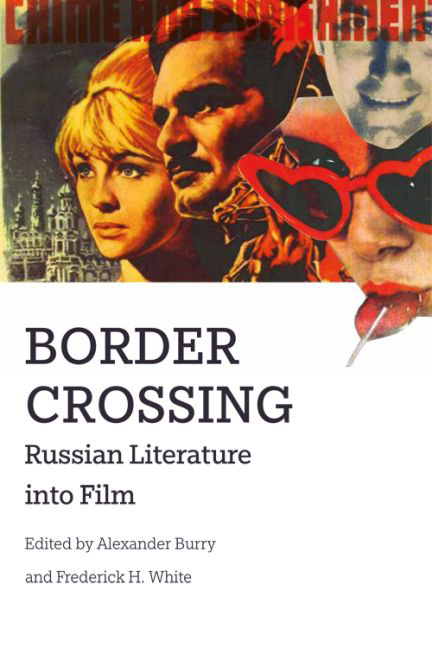Book contents
- Frontmatter
- Contents
- List of Figures
- Notes on the Contributors
- Introduction: Filming Russian Classics—Challenges and Opportunities
- 1 Across the Russian Border
- 2 Dostoevskii's “White Nights”: The Dreamer Goes Abroad
- 3 On Not Showing Dostoevskii's Work: Robert Bresson's Pickpocket
- 4 Stealing the Scene: Crime as Confession in Robert Bresson's Pickpocket
- 5 The Eye-deology of Trauma: Killing Anna Karenina Softly
- 6 “A Vicious Circle”: Karen Shakhnazarov's Ward no. 6
- 7 A Slap in the Face of American Taste: Transporting He Who Gets Slapped to American Audiences
- 8 Against Adaptation? The Strange Case of (Pod) Poruchik Kizhe
- 9 Chasing the Wealth: The Americanization of Il'f and Petrov's The Twelve Chairs
- 10 Fassbinder's Nabokov—From Text to Action: Repressed Homosexuality, Provocative Jewishness, and Anti-German Sentiment
- 11 “The Soviet Abroad (That We Lost)”: The Fate of Vasilii Aksenov's Cult Novel A Starry Ticket on Paper and on Screen
- Conclusion: Passport Control—Departing on a Cinematic Journey
- Bibliography
- Filmography
- Index
6 - “A Vicious Circle”: Karen Shakhnazarov's Ward no. 6
- Frontmatter
- Contents
- List of Figures
- Notes on the Contributors
- Introduction: Filming Russian Classics—Challenges and Opportunities
- 1 Across the Russian Border
- 2 Dostoevskii's “White Nights”: The Dreamer Goes Abroad
- 3 On Not Showing Dostoevskii's Work: Robert Bresson's Pickpocket
- 4 Stealing the Scene: Crime as Confession in Robert Bresson's Pickpocket
- 5 The Eye-deology of Trauma: Killing Anna Karenina Softly
- 6 “A Vicious Circle”: Karen Shakhnazarov's Ward no. 6
- 7 A Slap in the Face of American Taste: Transporting He Who Gets Slapped to American Audiences
- 8 Against Adaptation? The Strange Case of (Pod) Poruchik Kizhe
- 9 Chasing the Wealth: The Americanization of Il'f and Petrov's The Twelve Chairs
- 10 Fassbinder's Nabokov—From Text to Action: Repressed Homosexuality, Provocative Jewishness, and Anti-German Sentiment
- 11 “The Soviet Abroad (That We Lost)”: The Fate of Vasilii Aksenov's Cult Novel A Starry Ticket on Paper and on Screen
- Conclusion: Passport Control—Departing on a Cinematic Journey
- Bibliography
- Filmography
- Index
Summary
Anton Chekhov's “Ward no. 6” (1892) has inspired a large and varied body of hypertexts in the twentieth and twenty-first centuries. The story's basic premise of a psychiatric doctor who is incarcerated in the same mental hospital he used to run proved extraordinarily generative for Russian writers in the following century, especially given the notorious Soviet practice of labeling political dissidents insane. Valerii Tarsis and Venedikt Erofeev, among others, reflect this aspect of the story in their works. Other major themes of “Ward no. 6,” such as the unstable boundary between madness and sanity, psychological isolation from other people, and the elusive possibility of redemption—whether secular or otherworldly—have also proven important for Russian and Soviet writers.
Several film directors in Russia and abroad have also transported this hypotext to the silver screen, with equally diverse results. The most recent of these cinematic transpositions, Karen Shakhnazarov's 2009 Ward no. 6, represents a particularly innovative approach to Chekhov's story. If the dominant trend in the Russian ekranizatsiia (the term for screenings of literary works) of the early 2000s has been lengthy televised serials that attempt to depict the literary text as “accurately” as possible through period settings, Shakhnazarov diverges radically from this approach. Ward no. 6 is set in a present-day mental hospital in the Moscow outskirts, formerly the Nikolo-Peshnoshskii monastery. Even more strikingly, the director intersperses Chekhov's fictional plot with interviews of actual patients, “mockumentary” interviews about the head psychiatric doctor Ragin, and amateur, home video-produced flashbacks of the fictional doctor's past. The actors and patients coexist on the same narrative plane, and the continual cutting back and forth between the documentary of the present-day patients, the mockumentary of Ragin, and the fictional plot has the deliberate effect of fragmenting Chekhov's narrative, and disorienting the viewer. Shakhnazarov's film thus presents an unusual type of border crossing, as he transforms Chekhov's story both temporally, with his early-twenty-first-century Russian setting, and generically, with his pastiche of cinematic genres.
- Type
- Chapter
- Information
- Border CrossingRussian Literature into Film, pp. 121 - 139Publisher: Edinburgh University PressPrint publication year: 2016



